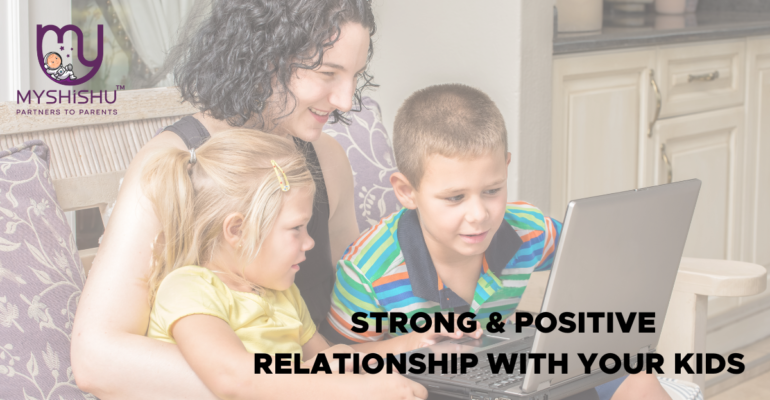Building a Fortress of Love: How to build a strong, positive relationship with your kids?
Building a Fortress of Love: How to build a strong, positive relationship with your kids?
Introduction
There is no magic to parenthood, but there is one foundation that underpins any successful parent-child relationship: a strong, healthy relationship. This relationship is a fertile ground where your child’s emotional well-being, self-esteem and resilience thrive. It’s a safe place to come back to after a knee injury or life stumbles. So how do we as parents become the architects of this emotional castle for our children?
Table of Contents
Think of it as a castle – a safe place where your children feel loved, supported and understood. This foundation of trust and relationships allows them to blossom into confident individuals ready to take on the world. But how do we build bricks, bricks, bricks, bricks, bricks? Here are some basic strategies:
Here are the main building blocks.
1. Quality timing: Build pieces of communication
In our fast-paced world, time is becoming a precious commodity. But when it comes to our kids, investing at the right time is the highest-return investment you can make. This doesn’t mean making great wines or going out expensive. It’s about crafting dedicated moments where you are fully present and immersed in their world. Here’s how to do it:
Unplug and Play with kids:
Build amazing Lego castles with your child, their eyes light up with creativity. Suddenly your phone buzzes. Fight the urge! Keep the TV and other distractions quiet and put your phone away. Get down to their level, literally and figuratively. This sends a powerful message that you are present and interested in their world. Let them take the lead. Are they building a spaceship out of Legos? Embrace the adventure and join their mission! Playing together based on their interests creates a deeper bond and allows you to see the world through their eyes.
Embrace the power of routine:
The comfort of a warm blanket on a cold night – that’s what routine can do for kids. Establishing simple and predictable communication time throughout the day can create a safety net in their ever-changing world. Bedtime stories are a nightly ritual, and time is near for cuddles and relaxation. Morning conversations provide an opportunity to connect before the busy day. After school visits can be debriefing sessions, a place to hear about their day and talk about yours. These routines need not be elaborate; Consistency and significance. Threads of communication are woven into the fabric of your daily life.
Find activities you both enjoy:
the shared laughter of conquering a tough hike together, or the fun of picking a movie and making popcorn for family movie night. Finding activities that you both enjoy will create fond memories and strengthen your relationship. Do you love the outdoors? Let’s look for other ways. Are you a movie buff? Choose a kid-friendly movie and turn it into a main event. By incorporating shared activities, you’re not just creating time together, you’re creating experiences that deepen your connection and create lasting memories.
Remember, timing is not about quantity. Even small pockets of focus go a long way in building a solid foundation.
2. The Art of Listening: Creating a safe space for connection
True listening goes beyond just hearing. It’s about giving your child your undivided attention, both verbal and nonverbal. Here’s how to create a safe space for open communication.
Be open-minded:
Don’t be afraid to hear criticism or complaints. Even if you disagree, affirm their feelings with a simple “I understand you’re upset.” This means you are open to their ideas and encourages them to express themselves freely.
Stimulate the conversation:
Go beyond yes-no-no questions. Instead, ask clear, detailed questions. “Tell me more about what happened at school today” provides an opportunity to share their experiences further.
Give them your full attention:
Active listening means being really present. Make eye contact, nod encouragingly, and interpret what you hear. “So it sounds like you’re disappointed because you didn’t get to play with your friends on vacation.” This means that you are listening and trying to understand their feelings.
By being an active listener, you show that your child is valued and heard. This builds trust and creates a safe space where they feel comfortable trusting you, even in difficult situations.

3. The power of reinforcement: building trust brick by brick
Positive reinforcement is like sunshine for a child’s self-esteem. It encourages them to keep trying, take risks and believe in themselves. Here’s how to get involved properly.
Celebrate the journey, not just the destination:
Imagine your child mentally messing with his face and finally completing a complex drawing. Instead of just praising the finished product, acknowledge the effort hard work, not just the results.”
Precision is key:
Vague “best practices” can lose their impact over time. Focus on specific positive behaviors. Did they use colors in their design? Show me that! Say, “I love how you used so much color in your picture! It makes it so vibrant!” This helps them understand desired behaviors and reinforces positive choices.
Turn mistakes into learning opportunities:
We all make mistakes, and kids don’t. Instead of focusing on your mistakes, use them as a learning tool. If your child is discouraged from erasing mistakes, offer encouragement and suggest an alternative. “You seem to be having trouble erasing that line. Maybe we could try another eraser next time?” This approach builds resilience and teaches them valuable problem-solving skills.
Remember, no praise is positively reinforced. It’s about acknowledging and celebrating your child’s strengths and efforts, and building a solid foundation of confidence.
4. Weathering the storm: Effective loving discipline
Discipline is an important part of parenting, but it should come from a place of love and guidance, not punishment. Here are some tips for good discipline:
Clear expectations, clear outcomes: Assume your child knows exactly what is expected of them. Set age-appropriate rules and boundaries. For example, timing ensures quality sleep, while the “no hitting” rule encourages respect. Take it slowly and clearly explain the consequences of breaking this rule. This creates a predictable environment where they understand the causes and consequences of their actions.
From mistake to suspicion: Your child spills on the carpet. Focus on solutions rather than blame. Work together to find solutions. This may include cleaning up spills or discussing ways to avoid similar accidents in the future. By being solution-focused, you teach them responsibility and problem-solving skills, and empower them to make better choices.
Learning from instincts: Imagine your child forgets his jacket on a cold day. Natural products can be powerful teachers. Feeling a little cold might be the best reminder to bring their jacket next time. Of course, use your own judgment – intervene if they are at risk of developing a dangerous flu. But allowing them to experience the natural consequences of their actions (within safe boundaries) helps them recognize responsibility and make better choices in the future
Effective discipline teaches responsibility and self-control. It’s about guiding your child, not breaking their spirit.
5.The importance of empathy: walking in their shoes
We have emphasized that empathy is the cornerstone of a strong parent-child relationship. Here’s how to develop this important skill and truly connect emotionally with your child.
Acknowledge their feelings:
This does not mean condoning their actions, but acknowledging their feelings. “Don’t be sad you can’t have another cookie,” instead of “I see you’re disappointed. The cookies are delicious, but we can have some fruit after dinner.” Validating their feelings shows you understand and creates a safe space for them to express themselves freely.
Use “I” statements:
“I feel frustrated when you throw away your toys” is much more constructive than accusatory statements like “You’re being such a bad boy!” “I” statements help your child understand the impact of their actions on others without feeling defensive.
Build on emotions:
Young children may struggle to express their emotions. Help them by naming the emotions you notice. “It sounds like you’re upset because your friend doesn’t want to share.” This helps them build their emotional vocabulary and manage their own emotions.
Offer comfort and support:
Acknowledge their feelings and offer comfort and support. A hug, a listening ear, or just being there can go a long way in helping your child get through difficult emotions.
By being empathetic, you create a safe space for your child’s emotions. They learn to validate and understand their feelings, fostering strong, trusting relationships.
6. Embracing their uniqueness: Celebrating who they are
Each child is an individual with unique talents, interests and personality. Resist the urge to mold them into someone they’re not. Instead, look at their individuality. Encourage them to explore their passions, whether it’s art, music, sports, or something completely different.
Celebrate their successes, small or small, in their chosen fields. This shows them that you value them for who they are and builds their respect and trust.
7. It teaches them: the importance of reliability and accuracy
Children thrive on routine and consistency. Knowing that you will be there for them, through thick and thin, gives them a sense of security.
Bonus tip: Embrace your flaws
No parent is perfect, and you will have slippery moments. You may be losing your patience or reacting harshly. Don’t be afraid. Sincerely apologize to the child, explain what happened, and practice. This lets your child know that everyone makes mistakes, and reinforces the message that open communication and forgiveness are important components of a healthy relationship.
Remember that building a healthy, strong relationship with your child is an ongoing journey, filled with laughter, tears, and everything in between. By combining these tips, you can create a safe and nurturing environment in which your child can grow and develop.
Additional Common Questions
I struggle to find quality time in my busy schedule. What are the emergency communication channels?
Even small pockets of attention have power. Put your phone away during the car ride, say a bedtime story, or have a little dance party at home.
My child doesn’t always want to talk. How can I encourage open communication?
Create a comfortable environment. Ask clear questions, listen loudly and without interruption, and reinforce their feelings. Sometimes just being there is enough to encourage them to open up.
My child gets frustrated easily. How can I help them cope?
Celebrate their efforts, not just the results. Use mistakes as learning opportunities and focus on finding solutions together. This gives them a sense of progress and helps them to cope with challenges.
What if I mess up? How can I repair the damage?
Everyone makes mistakes! Apologize sincerely, explain what happened, and use it as a lesson for both of you. Open communication and forgiveness are key to building a strong relationship.
Conclusion:
Building a strong and healthy relationship with your child is an ongoing journey, filled with laughter, tears, and everything in between. Remember, you don’t need huge crafts or endless hours – the key is to create a present, engaged and safe space where your child feels loved and understood. By incorporating these tips – quality time, active listening, positive reinforcement, effective discipline, and empathy – you will lay the foundation for a strong and satisfying relationship with your child. This relationship becomes their emotional fortress and source of safety and support as they navigate the world.
Remember, there is no one way to train parents. The most important thing is to be present, loving, and create a safe place where your child can thrive. By following these tips and maintaining a healthy relationship with your child, you will build a foundation of love and support that will last a lifetime.











